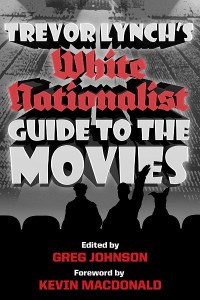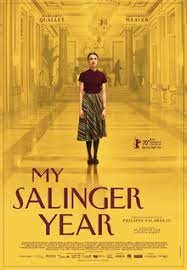Joanna Rakoff is a writer, and My Salinger Year is Philippe Falardeau’s film of her memoir about 1995, when she is on a visit to New York from Berkeley, fresh from university. The visit becomes permanent, however, because Joanna is a writer; she’s determined to make it, especially to get published in The New Yorker. Joanna, played by Margaret Qualley, is determined, a bit shy, and has a slurred, squeaky voice that hints English major. God knows, I heard enough of them.
Joanna finds work at a literary agency whose head, Margaret (a sedate, low-key Sigourney Weaver, whose white flanks of hair make her appear as a stand-in for Susan Sontag), is cool and all business. She takes Joanna on, and one of the newbie’s main tasks is dealing with endless armfuls of mail that are sent to the agency’s prima donna: J. D. Salinger. Joanna is under strict orders to shred all of the mail, as Salinger is reclusive and wants nothing to do with his worshipful public, shown in clever vignettes as they speak to the camera. There is a North Carolina adolescent (Theodore Pellerin), a Girl who wants an A (Romane Denis, and that’s how her character appears in the titles), and many others. It’s rather a good touch, letting these fans speak to the camera, and Joanna finds her job hard to do; she wants to connect with these people, and wants Salinger to connect as well. Joanna is a reluctant gatekeeper as she learns the ropes of publishing, all the while studying portraits of the agency’s clients: Salinger, Agatha Christie, F. Scott Fitzgerald, and so on. We’re in deep Lit. World here.
The movie is a literary version of The Devil Wears Prada, to which it bears more than a few resemblances, but it is essentially low-key, as literary types think themselves to be, and the film isn’t strident, as Devil was. The literary world isn’t as wild as high fashion, not to mention that this is a Canadian film.
Joanna, if outwardly compliant, is ready to explode, and My Salinger Year captures a world where New York is the center of the universe for all artistic life. As John Updike wrote, if you were an artist and didn’t live in New York, you were kidding. Joanna comes to New York to make it, as, so many fearless young intellectuals rushed to Paris in nineteenth-century French novels, and ambitious Englishmen herded into London. Joanna, in one of her many monologues, keeps expressing how vital it is to get published in The New Yorker, and when she, in low-key excitement, volunteers to take an author’s manuscript to its office, her gushing and tingling excitement is very real,
The film captures the ingenue ready to make it, with the usual trappings of an aspiring writer’s life, especially in that her boyfriend is also a writer who insists that her work should take a back seat to his efforts. He’s not exactly boorish, just a writer — which can be the same thing. Take it from one who knows.
Joanna is taken under Margaret’s wing and becomes a crackerjack editor and agent, but Joanna’s real heart is in writing. The compelling part of My Salinger Year is the relation Joanna has to Salinger — or rather, her lack of one. She’s never read Salinger, although she is dutiful enough to submit to his holy status in literature. Salinger does in fact appear, offscreen and on the telephone, randomly chatting up Joanna and encouraging her to write. Rather than the misanthropic recluse Salinger was reputed to be, or the holy man of American lit., Tim Post’s Salinger is conversational, approachable, and seems more normal than one would expect from the creator of Holden Caulfield.
The film’s major plot point is Salinger offering the republishing rights to his short story, “Hapworth 16, 1924,” to an independent small press. Joanna helps to organize this, which involves going to Washington, DC. While there she meets Karl (Hamza Haq), her old boyfriend who is a musician . She just misses Salinger, only seeing his back as he is leaving after making a deal, and this leads to a lyrical sequence where she dances with Karl in a hotel lobby, joined by others. Not catching, but dancing in the rye?

You can buy Trevor Lynch’s White Nationalist Guide to the Movies here
Early in the film, Joanna is warned that when Mark David Chapman shot John Lennon in front of the Dakota Hotel in New York, he had a copy of Catcher in the Rye with him, and believed he was Holden. Indeed, when he was captured by police on 72nd Street, he was reading from the book.
Joanna understands the necessary distance artists need to maintain to stay safe, but again is bothered by the fans who get no reply from their idol. Yet, what does an artist owe his public except to create, to please, and perhaps to teach? The public is certainly expected to buy, and might be expected to learn, but that’s iffy. Salinger was a special case in point because he was idolized by a generation in a way we might find incomprehensible today, when writers no longer enjoy the same adulation. Catcher in the Rye was a sacred document to millions of young people, and Holden was their boy.
This isn’t unusual. When Goethe wrote The Sorrows of Young Werther in 1774, Europeans — including no less a person than Napoleon Bonaparte — idolized the nature-loving, intellectually isolated and romantic Werther. Some even copied the character’s decision to commit suicide, seeing it as the epitome of Romanticism. The yellow vest he wore was adopted by many, similar to how some later took to wearing the hunting cap worn by Holden Caufield as he wandered New York.
Salinger seemed bewildered and annoyed by his fans (especially those who showed up at his farm), and ultimately broke off contact with the outside world to dwell in Cornish, New Hampshire, leading to the hermetic life the film depicts. Salinger’s reputed brusqueness seemed to have softened by the 1990s, however. He is friendly to Joanna, but his meeting with the publisher is still treated as a walking-on-eggs affair. It is felt that if there is one wrong word or gesture, Salinger will fly off like a bird fleeing a trap.
Salinger’s isolation was legendary. Attempts to obtain interviews were invariably immediately rebuffed, and he could be caustic in response to queries about what he was writing, given that his last piece of original work published in his lifetime appeared in 1965. It was assumed Salinger hadn’t really left the world of letters, but was sowing a series of great works in solitude, ready to astound the world when released posthumously. Although he passed away in 2010, as of now they still haven’t appeared.
Of course, there is the question whether Salinger was abandoned by the youth his book so energetically overwhelmed, and whether his seclusion in part concealed the fact that he couldn’t write anymore — or that he was simply overrated. Gore Vidal held this belief, although he thought Salinger was a good writer — although as he pointed out, Salinger fed the self-pity of the young, and did it very well.
Catcher in the Rye was praised for, as Anthony Burgess put it, the innovation of a special narrative style that was a breakthrough in that phase of Anglo-American literature. Certainly many have claimed that it is a jaundiced, modern Huckleberry Finn, offering an intimacy and directness that had not been seen in American literature up to that time. For many admirers, what mattered was the sense that Holden spoke for them; he was them, and they Holden. It was therefore no surprise that many of these fans flocked to Salinger, or wanted to. He didn’t want to be a holy man. But the effect of disappearing from public life only made Salinger even more an avatar of youthful longing and dissent.
It is fair to say that in my generation, for all those who revered Salinger, there were an equal number who wanted him to die so they could start creating works based on him. Hollywood in particular was chomping at the bit, having wanted to make a film of Catcher in the Rye for decade. After Salinger’s death, a biographical film, Rebel in the Rye, indeed came out in 2017 — but there was no great joy at its premiere. It was a good, balanced film, and perhaps its muted reception indicated that the generation that had revered Salinger had almost died out. He seemed timeless to me when I grew up, devouring and being overwhelmed by Catcher in the Rye, but so do all the favorites of youth. I mentioned Werther; in my day there was also Hermann Hesse and Kurt Vonnegut. Does anyone even remember them now, let alone read them?
I propose people reread Catcher every ten years, using it to note their emotional and literary progression. Holden in turn becomes a hero, an annoying punk, a self-absorbed misanthrope, a sad kid in need of help, and, in the end, an enjoyable observer whose outlook, if limited, is never dull.
But in the 1990s, at least according to Rakoff, Salinger was still the shrouded guru of the downtrodden. Joanna tries to be a bridge by writing her own replies to Salinger’s legions of fans, but fails, as they want Salinger himself, not her. An especially bittersweet scene depicts The Girl Who Wants an A, in her school uniform and nose ring, marching into the office and denouncing Joanna for writing her advice on how to live and become wiser. She rages that she wasn’t helped by Salinger, and will have to repeat a year in school because of her dismal scholastics. “And it’s your fault!” she screams at a speechless Joanna before striding off under the stained glass of the lobby’s office.
Joanna has to balance her concern for the readers with her own life, which is now stagnating under the weight of Salinger, the inattentiveness of her writer-boyfriend, and her growing responsibilities at the agency, where Joanna is learning and impressing everyone — but what about her own writing, and her dream to be in The New Yorker?
Joanna does some soul-searching towards the end of the film. She dumps her boyfriend, dusts off her poetry, smokes cigarettes, gets a new apartment, and revises her work on the subway, street, and at the cafe. She smokes more cigarettes. She’s finally published, and at the agency, Margaret offers her a senior position. But Joanna says no; she has to write. Margaret sadly tells Joanna she was afraid this would happen. The film ends with Joanna, who once delivered manuscripts to The New Yorker, now being sent to an editor there to discuss her new selection of poetry to be published; and finally, Salinger pays Margaret a visit at the agency, and Joanna is introduced to him — or rather, a view of his torso sans face, for in this film Salinger, like Allah or Jesus in Ben-Hur, is too holy to be shown in his entirety.
I enjoyed how Falardeau depicts the writer’s life — especially that of the New York writer, where you claw and scrape in order to be published, living in awful apartments (Joanna and her boyfriend have to wash dishes in the bathtub because they have no sink) and putting up with the overcrowded, dingy city because that is where you make it. Martin Leon’s score is also diverting and clever. The New York of My Salinger Year looks very antiseptic and well-kept compared to the New York I remember, and is amazingly white — but it was filmed in Canada, where even slums looks tidy.
But in this nostalgic reverie, there is a subtle message that one should be a writer, not merely a disciple or gatekeeper of talent. In the end, a writer’s public is not his, and becomes its own creature. The flock of Salingerites have no relation to Salinger himself, even though he created them. Once a writer’s work is released, whether it fails or triumphs, it is his child. As James Howard Kunstler noted upon finding some of his old novels in the discount bin at Kmart, it’s like finding a beloved relative in the gutter clutching a bottle in a paper bag.
Salinger was obviously appalled at his cult status. Other writers are more willing to become embodiments of literature, such as James North Patterson. The rest of us get by, having offered something that the world at large will likely reject or feign indifference to — but we offered something of ourselves, our fantasies, creations cast into words that, as John Updike said:
Given me my quitclaim in the sun
Sealed shut my adolescent wounds, made light
Of grownup troubles, turned to my advantage
What in most lives would be pure deficit,
And formed, of those I loved, more solid ghosts.
This film is a cinematic piece of chamber music where Joanna Rakoff escapes being a catcher in Salinger’s rye — Holden’s fantasy of catching and saving children from corruption. Joanna can’t protect and succor Salinger’s readers, which are his children. Instead, Joanna becomes a catcher herself, creating her own literary children — which after all is the point of the artist.
* * *
Counter-Currents has extended special privileges to those who donate $120 or more per year.
- First, donor comments will appear immediately instead of waiting in a moderation queue. (People who abuse this privilege will lose it.)
- Second, donors will have immediate access to all Counter-Currents posts. Non-donors will find that one post a day, five posts a week will be behind a “Paywall” and will be available to the general public after 30 days.
- Third, Paywall members have the ability to edit their comments.
- Fourth, Paywall members can “commission” a yearly article from Counter-Currents. Just send a question that you’d like to have discussed to editor@counter-currents.com. (Obviously, the topics must be suitable to Counter-Currents and its broader project, as well as the interests and expertise of our writers.)
To get full access to all content behind the paywall, sign up here:
Paywall Gift Subscriptions
 If you are already behind the paywall and want to share the benefits, Counter-Currents also offers paywall gift subscriptions. We need just five things from you:
If you are already behind the paywall and want to share the benefits, Counter-Currents also offers paywall gift subscriptions. We need just five things from you:
- your payment
- the recipient’s name
- the recipient’s email address
- your name
- your email address
To register, just fill out this form and we will walk you through the payment and registration process. There are a number of different payment options.
My%20Salinger%20Year%3A%0AChamber%20Music%20for%20a%20Writer%0A
Share
Enjoyed this article?
Be the first to leave a tip in the jar!
Related
-
Joker: Folie à Deux – the Great White Nope
-
Fantastic Lies
-
Lucky for Some: John Carpenter’s Assault on Precinct 13
-
The Unbelievable World of American Theater
-
Halloween Reading at Counter-Currents
-
King Arthur: Knights, Action, and Colonization
-
Widow Clicquot: The Napoleon of Wine
-
Comparing Film: The Matrix and Ich Klage An

3 comments
I thought the comparisons of this film to The Devil Wears Prada were a tad unfair, as DWP was much more of a “Hollywood” popcorn movie, completely over the top and in love with itself. I thought this one at least made an attempt to be thoughtful. It does have the same basic plot, however.
Fun fact about Salinger: he ended up becoming good friends with Judge Learned Hand, who also lived his later years in Cornish, New Hampshire. Both men were introverted to the point of crankiness, which of course explains why they got along like gangbusters.
Hated that book Catcher when I read it in 1999. So overrated. That was during my period of catching up in the « modern classics » when I graduated high school and moved to the city (Minneapolis). I read other duds afterwards like To Kill a Mockingbird and Roots. Although I did like Another Country by James Baldwin.
Salinger’s decline as a writer and as a human being is easily explained. Salinger, like other “agents” (as Miles Mathis would call them), was a midwit hack who agreed to serve as front man for a project in the CIA’s postwar Operation Chaos, which was to turn confused adolescents into “rebels without a cause” or, when needed, psycho killers. As such, the word went out “Promote Salinger” and the Hive (publishers, academics, critics, etc.) swung into action. Catcher was likely written by the team at Langley, while the later Glass Family stuff was his own, hence the sharp decline. Becoming a “hermit” is a great way to exit an agent after his job is done.
As for “does anyone read Hesse,” the answer is, well, yes. See my “Two Orders, Same Man: Evola, Hesse.” https://counter-currents.com/2017/06/two-orders-same-man-1/
“Unfortunately, the deep writer and poet Hermann Hesse was falsified and vulgarized by a world in decline. He needs to be re-read today by the same eyes that were once shaken by his mystery.” – Miguel Serrano, “To Re-Read Hesse.” https://counter-currents.com/2011/03/to-re-read-hesse/
Comments are closed.
If you have a Subscriber access,
simply login first to see your comment auto-approved.
Note on comments privacy & moderation
Your email is never published nor shared.
Comments are moderated. If you don't see your comment, please be patient. If approved, it will appear here soon. Do not post your comment a second time.